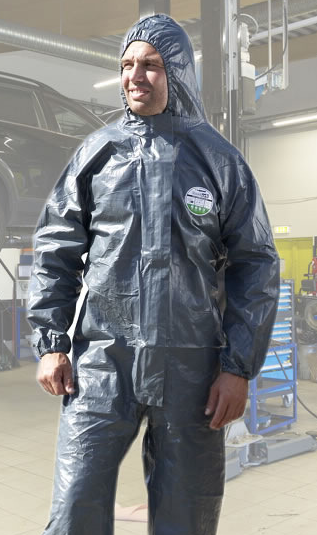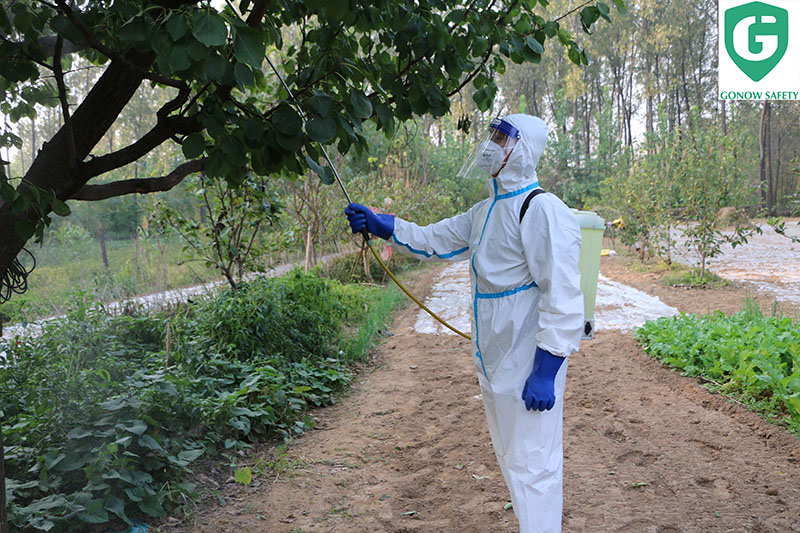Chemical protective clothing is essential for workers exposed to hazardous chemicals in various industries, from chemical manufacturing to construction and agriculture. With the wide variety of chemical protective suits available, it’s important to understand the different types, the corresponding European standards, and how to select the right protective clothing for your specific needs.
Types of Chemical Protective Clothing and EN Standards
Chemical protective clothing is classified into six types, each offering different levels of protection. The standards for these suits are outlined by European Norm (EN) regulations, which define the performance requirements and test methods to ensure the garments provide adequate protection.
Type 1 – Gas-tight Protective Suits (EN 943-1 & EN 943-2)
Key Features:
- Full Protection: Type 1 suits are designed for environments where the worker may be exposed to toxic gases or vapors. These suits provide the highest level of protection and are gas-tight, preventing any chemical from penetrating.
- Applications: Used in chemical factories, hazardous material spill response, or any scenario involving toxic gases.
Chemical Protection Level:
- Gas-tight: Complete protection against gases, including corrosive and toxic substances.
- Specialized Materials: Often made from laminated materials like rubber or polymer films to ensure impermeability.

DuPont Tychem-1000 Hazmat Suit offers reliable protection against a wide range of hazardous chemicals, ideal for use in emergency response, industrial applications, and environments with chemical exposure risks.
Type 2 – Liquid-tight Protective Suits (EN 943-1 & EN 943-2)
Key Features:
- Liquid Protection: Type 2 suits provide protection against chemical liquids and can be used when the risk of splashing or spills is present.
- Applications: Common in industries like chemical manufacturing, pharmaceutical production, or hazardous waste management.
Chemical Protection Level:
- Liquid-tight: Effective against chemical splashes and spills.
- Comfort: Typically less bulky than Type 1, offering more mobility while still ensuring protection.
Type 3 – Jet-tight Protective Suits (EN 14605)
Key Features:
- High Protection for Liquid Jets: These suits protect against high-pressure liquid jets, ideal for situations where workers may be exposed to pressurized chemical substances.
- Applications: Emergency responders, chemical spill clean-ups, or tasks involving high-pressure systems.
Chemical Protection Level:
- Jet-tight: Offers resistance to liquid chemicals under high-pressure conditions.

Ansell® AlphaTec 3000 AVANT AIRline Model 755 (Yellow) – Type 3 protective suit designed for enhanced comfort and superior protection in hazardous environments, ensuring safety during chemical handling and other high-risk tasks.
Type 4 – Protective Suits for Spray (EN 14605)
Key Features:
- Spray Protection: Type 4 suits provide a barrier against liquid chemical sprays. They are suitable for work environments where workers are exposed to chemicals in mist or spray form.
- Applications: Agricultural workers applying pesticides, chemical cleaning operations, or any task with potential for chemical spray exposure.
Chemical Protection Level:
- Spray-tight: Effective against spraying chemicals in the form of droplets or mist.

The LAKELAND ECR428 is designed with advanced protective materials to offer superior chemical protection and durability, making it ideal for high-risk work environments. This product meets stringent safety standards to ensure maximum protection and comfort for the wearer in extreme conditions.
Type 5 – Dust-tight Protective Suits (EN ISO 13982-1)
Key Features:
- Dust Protection: Type 5 suits are designed to protect against harmful dust and solid particulate matter. They provide a high level of protection when working with fine powders, dusts, and particulate chemicals.
- Applications: Pharmaceutical manufacturing, mining, or industries dealing with hazardous powder substances.
Chemical Protection Level:
- Dust-tight: Ensures complete protection from harmful dusts and particulates.
Type 6 – Splash-tight Protective Suits (EN 13034)
Key Features:
- Splash Protection: Type 6 suits offer protection against small splashes of liquid chemicals. They are commonly used when workers are exposed to low-risk chemical spills or splashes.
- Applications: Laboratories, cleaning crews, or industrial environments with minimal exposure to chemicals.
Chemical Protection Level:
- Splash-tight: Ideal for light splashes of chemicals or liquids in low-risk environments.

The 3M 4510 coverall offers reliable dust protection and liquid splash resistance. Crafted from durable non-woven fabric, it features an adjustable hood, a front zipper, and elastic cuffs for added comfort and safety. Perfect for environments with exposure to dust, non-hazardous liquids, and mild chemicals. Ideal for use in construction, manufacturing, and industrial settings where PPE protection is essential.
Choosing the Right Chemical Protective Suit
Choosing the right chemical protective suit depends on several factors, including the type of chemicals involved, the nature of the exposure, and the working conditions. Below is a table outlining the key factors to consider when selecting the appropriate suit:
| Factor | Considerations | Recommended Suit Types |
|---|---|---|
| 1. Protective Level | Based on the hazard of the chemicals. High-risk environments need a higher level of protection. | Type 1 or Type 2 for high-risk/toxic chemicals, Type 5 or Type 6 for lighter exposures. |
| 2. Exposure Time | For extended exposure, choose suits with better sealing properties. Short-term exposure allows more flexibility while maintaining protection. | Type 1 or Type 2 for prolonged exposure, Type 4 or Type 5 for short-term exposure. |
| 3. Comfort & Fit | Ensure the suit allows ease of movement without compromising safety. Ill-fitting suits can reduce effectiveness. | Suits with adjustable features or ergonomic design for comfort and flexibility (all types). |
| 4. Chemical Type & Risk | Consider the chemical involved (volatile, mild, etc.). Gas-tight suits are required for volatile chemicals, while splash suits are for milder ones. | Type 1 or Type 2 for volatile chemicals, Type 6 for splash protection of mild chemicals. |
Case Studies: Real-World Examples
1. Chemical Manufacturing Plant (Germany): A chemical manufacturer dealing with toxic gas leaks selected Type 1 gas-tight suits for all emergency response personnel. The suits successfully protected workers from exposure during a hazardous gas leak, ensuring zero injuries.
2. Construction Site (Spain): During an operation involving chemical sprays on a construction site, workers wore Type 4 suits. These suits provided adequate protection against chemical sprays, and no exposure incidents were reported.
3. Agricultural Application (UK): An agricultural firm in the UK used Type 3 suits for pesticide spraying. Workers were shielded from harmful chemicals, ensuring their safety during the entire spraying operation.

This picture shows a worker wearing Type 5/6 protective coveralls with adhesive strips while spraying pesticides. Please take note that:
- Short-term exposure: For brief pesticide exposure, Type 5 and Type 6 protective coveralls effectively prevent liquid splashes. However, it’s crucial to wear chemical protective clothing correctly and not rely on luck—after all, safety should always come first.
- Long-term exposure or high concentration of pesticides: For prolonged contact or spraying of high-concentration pesticides, it is recommended to use protective clothing with a higher chemical protection rating, such as Type 3 (liquid-tight suits) or Type 4 (spray-tight suits). Additionally, ensure the use of appropriate gloves, boots, and respiratory protection.
Summary: Choosing the Right Chemical Protective Suit
Selecting the right chemical protective clothing is crucial to protecting workers in hazardous environments. Understanding the different types of suits, their corresponding European standards, and their protective capabilities will allow you to make an informed decision:
- High-risk environments: Opt for Type 1 or Type 2 suits for maximum protection.
- Medium-risk environments: Type 3 or Type 4 suits provide excellent protection against liquids and sprays.
- Low-risk environments: Type 5 and Type 6 suits are suitable for dust and splash protection.
By carefully considering these factors and referencing relevant standards, you can ensure that workers are adequately protected from chemical hazards, improving safety and minimizing risk.
In the field of chemical protective suits, several renowned brands are recognized for their high quality and wide application. Below are some of the most well-known brands in this area:
1. DuPont
Tyvek® Series: DuPont is a leader in protective clothing, and the Tyvek® series is well-known for its protection against chemicals, dust, liquids, and microorganisms.
Tychem® Series: The Tychem® series offers higher levels of chemical protection, commonly used in the chemical, oil, and emergency response industries.
2. 3M
3M offers a variety of personal protective equipment, including chemical protective suits. These suits are typically used for handling hazardous chemicals, wastewater treatment, and emergency response situations.
3. Honeywell
Honeywell’s protective suits are known for their durability and comfort, and are suitable for industries such as oil, chemicals, and mining. Honeywell’s Sperian protective suits are also widely recognized globally.
4. Ansell
Ansell is a global leader in personal protective equipment manufacturing. Their chemical suits and gloves are widely used in industries such as healthcare, chemicals, and manufacturing. Ansell suits are commonly used in environments involving hazardous chemicals or biological risks.
5. Lakeland
Lakeland Industries offers various types of protective clothing, including chemical suits and isolation suits. Their products are widely used in industrial and healthcare fields, especially in environments dealing with toxic substances and biological hazards.
These brands’ protective suits are widely used in high-risk environments such as chemical spills, petrochemical industries, agriculture, healthcare, and environmental cleanup. Each brand offers a range of suits designed to protect against various hazards. In addition to these brands, several others excel in chemical protection. For any needs or inquiries, please feel free to contact us. Our experts are here to provide tailored solutions to meet your specific requirements.


